Respected Resident of Corralitos Died in Santa Cruz:
Death in the form of a third paralyzing stroke at Santa Cruz yesterday ended the sufferings of A. P. Guinn, an estimable resident of Corralitos. Deceased came to this valley in 1905, and has resided here ever since. He engaged in farming, but failing health compelled him to retire about two years ago.
Mr. Guinn was a very fine man, and enjoyed the confidence and esteem of all who knew him. He raised a large, very creditable family of children. He was a native of Missouri, and was aged 72 years. He was a member of the Christian Church.
Besides his sorrowing wife, Emelin Guinn, he is survived by the following children: Mrs. Bert Huntington, Mrs. W. H. Kirkman, Mrs. Theo. Caudill, Mrs. Lester Phillips. Mrs. Gilbert Bradley and Harry Guinn, all of Corralitos; Edward Guinn of Soquel; Mrs. Ammon Davis and Fred Guinn of Gilroy and Lloyd Guinn.
The funeral will be held from the undertaking parlors of Aston & Neal, Odd Fellows' building, this city, on tomorrow, Thursday, Aug 30, 1923 at two o'clock in the afternoon. Interment in the Odd Fellows' cemetery.
The first place my parents bought was on Eureka Canyon Road across from where the filter plant is today. The Tindalls were our next door neighbors. (Photo #3 in Mementos II Bradley and Tindall houses on the right) We were there when I started school at the second schoolhouse on Aldridge Lane. Ruth Karstedt Smith was my first teacher. One day I was on the heavy, wooden teeter-totter with Arthur DeLaPena, and while I was up high in the air he stepped off the other end. I dropped and fell to the ground. I felt paralyzed. I was a tiny kid weighing only 37 pounds. Mrs. Smith came over, picked me up, and carried me inside our classroom. She told the kids that we wouldn't have any more lessons for the day. She said she was going to hold Hazel and read stories. That was what she did until it was time to go home.
My parents bought me a new lunch pail to take to school. One day I came home and my mother noticed my lunch box wouldn't open. When she asked me about it, I told her it was broken. She asked me how it got broken. I said it had a dent in it. Then she asked me if I knew how it got a dent. I told her it had a dent because I hit Chucky Lemon over the head with it because he wouldn't stop teasing me!
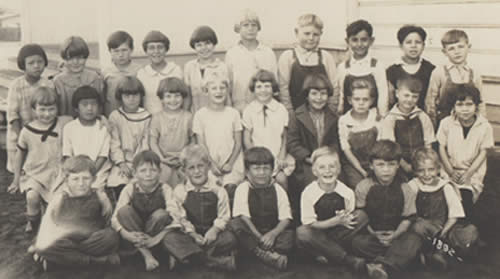
First grade with Hazel in center of group ( Some names available)
One day when the mail arrived, there was an ad from the Fox Theater. It was on heavy paper so I asked Mama if I could have it. I made a little boat with it, then pulled an old box up to the rain barrel so I could float my boat. While I was leaning into the barrel, the box fell away and I went into the water headfirst. I couldn't turn myself, but my foot could touch the faucet that was above the barrel. I maneuvered my foot around the faucet and was able to pull myself up. I walked up to the porch and knocked on the door. My grandma came to open the door. When she saw me she yelled for Mama. I was standing there drenched in my red wool sweater and overalls, and I had green moss in my hair because my head had gone to the bottom of the barrel. After they warmed me, Grandma held me and told me God was watching over me that day. I told her I didn't know about God, but I was sure glad that faucet was there!
We always went camping in the summer. Once we set up a tent at Manresa Beach so we could spend the night there with my Uncle Harry and Aunt Lola Guinn. We were near the water line and during the night, a light was shone on our tent. I heard my father say for no one to go out. We could hear voices from the cliff and could see a boat shining a light from the water. A rowboat came in on the shore, while all the time the light was on our tent. It was bootleggers bringing in a shipment and we were in the middle of it. They finally all went away.
| When my Uncle Harry won a contest at a local gas station, we went to their home in Watsonville to see his prize. The prize was a child-size replica of a car. After that, whenever we went to visit they would get it out of the garage so we could play with it. It had pedals and a steering wheel. My little cousin, Alice, was too short to reach the pedals so she would ride on her tricycle. She liked to pretend she was giving me a ticket. |
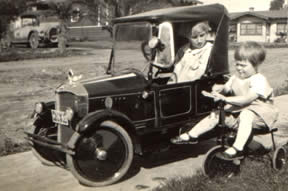 |
I was thrilled to be asked to take part in our next door neighbor's wedding shower. Annie Tindall was going to marry Gus Bailey. For the shower, I was dressed in a crepe paper dress. My mother curled my hair with a curling iron that had to be heated by putting it inside the top of the coal oil lamp and turning the lamp to low. I thought I looked so cute. I pulled a wagon that was decorated with crepe paper and filled with gifts. I got to pass out the gifts when Annie opened them. Gus thought I was so cute, too. When I got the measles, he would come over everyday to see how I was. He would caution my mother to be sure to keep our green shades down. He said the light could damage my eyes. He was so concerned because he had had measles and his eyes had been affected.
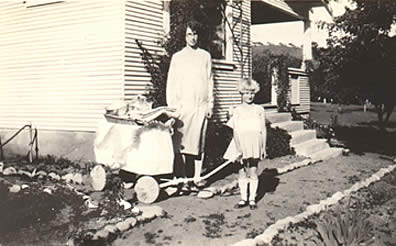
When I was seven, I loved to play at my cousin, Albert Huntington's, house. Aunt Stella was my mother's sister. Uncle Bert had the last blacksmith shop in Corralitos at 490 Corralitos Road . There were so many things to see in the shop like the bellows and all kinds of iron. Albert made me rings with the horseshoe nails. One day, my mother asked if I wanted to spend the night there. I sure did and I was so happy. About 7:00 in the evening, my father came to the house to get me. I told him Mama had said I could stay. He said they wanted me to come home to meet my new sister. While riding home I wasn't too happy about leaving, and also I was wondering where the heck they got a kid! When we got home, Mama was in bed and had something under a blanket on her shoulder. She asked me if I would like to see my new sister, Helen. I lifted the blanket and looked at that tiny little face. I was crushed because I thought they had a kid for me to play with. I went down on my knees, lay my head down and cried. Mama asked why I was crying. I told her it was because the baby was so tiny, and she was red!
Not long after Helen was born, my parents bought a twelve-acre apple ranch on Amesti Road near the “honeymoon house.” There was a big house on the property with indoor plumbing and a washing machine. My dad worked the orchard and we all liked it there.
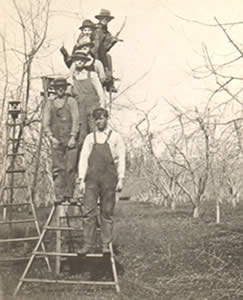
Top to bottom: Ira Phillips, Eldon Dye, Gilbert, Claude and Homer Bradley, Luther Fritz
I don't remember why, but one day I decided to run away from home. When I told my mother, she put a red handkerchief on the end of a stick and put a sandwich in it. She gave it to me and told me to be careful. Grandma was crying as Mama told me good-bye. I went outside and walked across the road. Somehow I hurt my finger. I went back inside and showed Mama. After she looked at it she said, “Oh, Honey you have to be careful out there. Now it is going to get dark, so you better hurry and go.” Grandma was still crying. I told Mama I thought it was too late, so I would do it some other time. That was the last time I ever did that.
During the Depression, my Dad could not make enough money to keep up with the mortgage. He worked for 25 cents an hour doing orchard work for E.W. Jack, Emeral Dickie, and anyone else he could work for. At night, he would come home and work his orchard with a light on his tractor. When we lost our ranch in 1933, there were no rentals left in Corralitos. The Bellangero's old family home was on the hillside on their property on Brown's Valley Road above where they had built a newer home. They said we could live there. It was in shambles. We had to put blankets up against the cracks at the door so lizards wouldn't be on our beds in the morning. It didn't even have an entire roof. We could see the sky when we were inside the place. One time when it was raining, Lymon Spain and his wife were coming to visit. There was a potbellied stove in the middle of the room, so for a joke we were sitting around it with umbrellas when they came in the door. The water would come through the roof and it had leaked into my piano, so that the keys in the upper octaves froze. Mama had bought the piano for me from the Christian Church when it was closed. She had wanted me to learn to play. For two or three years, I had lessons from Olive Brewster. She lived with the Phillips family in a house that used to be on Corralitos Road opposite Merk Road. She played the big pipe organ during intermissions at the Fox Theater. My lessons cost 50 cents a week.
Fred and Ermalee Frederick had built a house on Brown's Valley Road next door to the Manchesters. They were not moving in to it until they were married, so they invited us to live there until that time. When we moved down to the Frederick house, my aunt, Elma G. Bradley, who lived across the road from us, came to the house and told my parents that she would like to pay for me to continue my lessons for one year. Pearl McFarland was the best piano teacher in Watsonville, and she came out to continue my lessons. She would bring her little spaniel with her. When it had a tooth problem she took it to the dentist. It got a nice gold tooth.
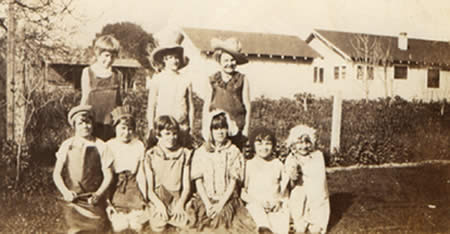
Margaret Diehl's birthday party at the Manchesters on Brown's Valley Road with Frederick house in the background
Back - L to R: Isabel Bradley, Hazel, Margaret. Front - L to R: Melba Caudill, Eunice Krieger, Grace Bradley, Kathleen Carpenter, Mildred Parsons, Norma Rippy
After a time, a rental became available next to Ceschi's Hall and we moved there. Before the Grange Hall was built, Ceschi's Hall was the main place the people in the community gathered for events. A group from the Christian Church had skits and plays there. My Uncle Harry was always cast as the villain, and my mother was always the damsel being hassled. They told me that when I was about three or four, every single time, because I'd see my mother seemingly in distress, I would start bawling. The audience would laugh thinking I was playing my part so cute. The WCTU also met there. One time I was in their Silver Medal contest. I had to stand on the stage in front of a lot of people and say a little speech. It was scary, and I didn't win. Connie Brodin won the medal that time. When I was about ten years old, on Halloween my parents left me at a big masquerade party at the hall. I hadn't been there very long, when an older boy began to tease me. When he smacked me in the nose, I walked out the front door and started heading for my Uncle Harry's. That is where my parents were for the evening. At that time, they lived off Aldridge Lane down the dirt road that is on the hillside. It was dark and the road had tall bushes on both sides. When I got to the house, they were very surprised to see me. I told them what had happened and how mad I was. My mother always said I looked like a wasp in a frying pan when I got mad. One time when the county nurse was at the hall, one class at a time marched there from school for small pox vaccinations. Helen Jensen, the daughter of the Jensens who started Alladin Nursery, was standing in front of me. She was so scared, so I told her I would go first and show her it didn't hurt. When I was done I said to her, “See, nothing to it.” After the hall was closed, my friends and I would go inside to roller skate. No one ever told us we couldn't.
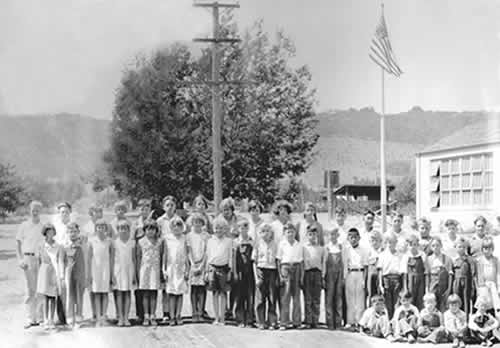
1930 Hazel in fifth grade is fourth from left front row (Names are available)
A third schoolhouse was built on Aldridge Lane and the old one was removed. I was there from third grade until I graduated from the eighth grade. When I had Mrs., Munson in fifth grade, it seemed I was always in trouble. She sat me in the hall or put me in the closet to get me away from the class. I made them laugh and they wouldn't do their work. Once a week at lunchtime, I would divide my lunch with some of the kids, then I would go up the flume to Uncle Homer and Aunt Edna's when they lived at 44 Aldridge Lane. This is when my aunt baked. She would cut the ends off her freshly baked bread and that would be my lunch. I told the kids never to tell on me or I wouldn't share my lunch with them anymore. It was against the rules to go into the flume, so I had to lean down so no one would see me. Mrs. Munson didn't get any rest when I went into sixth grade since she was still my teacher. I got very good grades, but my report card had a line of red Xs for deportment. My aunt, Elma, was the principal and she told me one day to ask my parents to come to speak with her. I didn't tell them, so one day she drove over to our house. She told my parents that she thought I was bored with the schoolwork and that was why I was disruptive in the classroom. She wanted to move me into seventh grade so that the work would be more challenging to me. I ended the school year with six months of sixth grade and three months of seventh, and then I went into the eighth.
Aunt Elma was my eighth grade teacher. The work was hard so my grades weren't as high as they would have been if I hadn't been skipped through the grades. I wanted to be valedictorian, but wasn't chosen. At the end of the year, we had our graduation photo taken. I was seated at the end of the front row. I was so mad and a little hurt. A girl, who had only been at the school for eighth grade, got to sit next to Aunt Elma and held her hand. Her father, Mr. Handshy, was the principal at the high school. I thought I should have been next to her because she was my aunt. Besides that, when I saw the photo, my slip was showing! (8 th grade graduation photo in Mementos III #26)
I went to Watsonville High School. Thelma Bradshaw was one of my good friends, and also a girl named Marguerite MacGregor, who had moved to Corralitos from Colorado to live with her grandparents. Her grandmother, Nanny Crowl, owned a dress shop in town. One time I stayed with her when her grandparents were out. It was a bright, moonlit night so she and I decided to take off all our clothes and dance naked on their lawn in the moonlight. They lived at the corner across Hames Road from Blake Road. In those days there were very few cars on the road.
I wasn't allowed to date boys alone until I was sixteen. I had a lot of boy cousins that my parents trusted so I got to go a lot of places with them. My cousin, Eddie Guinn, and I would fish up Eureka Canyon when it was trout season. We would catch our fish then he'd clean them, string them up, and build a little fire to cook them. He always carried salt in his creel so we would eat our catch right there by the creek. Then, we'd fish some more and take some home.
I had learned to dance at the same time my parents did at the Grange Hall with my Aunt Bertha Bradley playing the piano. Her son, Frank, had a car so I went with him places like Coconut Grove and Capitola Ballroom for dances. We dressed up, and sometimes I wore formals. There were Saturday nights when my friend, Louise Garbarino (Peterson), would come to my house. We would lay out our clothes, primp, and curl our hair, and then go to the dances at the Grange Hall with my parents. We thought we were the belles of the ball.
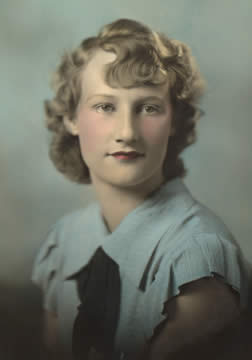
I was seventeen when I graduated from high school. I tried to get a job at the telephone company, but I was too short to reach the switchboard. I was only 5'2” and so young no one wanted to hire me. I worked doing whatever I could. I worked for Rider's in the apples and for Ben Ceschi in his orchard raking and burning brush. I did housecleaning for Mrs. Helen Scott, next to the market, three hours a week for $1.00. She let me use her library that had encyclopedias and other books to read. One day, I saw a sign in Pleasant Valley that said “ Pickers Wanted,” so I went there and told them that I would like a job. The man handed me a twelve-foot ladder and said, “Go pick cherries!”
About 1937, we moved to Mrs. Lord's house. (543 Corralitos Road) My parents then bought the property when she decided to sell. John and Florence Rippy bought the second house (547) on the Lord property from my parents. My dad's brother, Homer, and his family moved to the other side of the Rippy house and his brother, Claude, and his family lived on Hames Road.
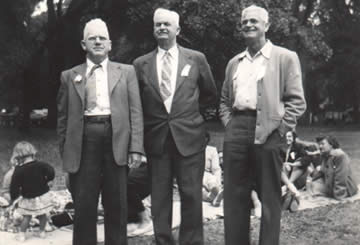
Brothers Homer, Claude and Gilbert Bradley
At the Grange dances I met the Johnson boys, Joe, Norman and George, and their cousin Glen. I dated Glen first, but Norman was the one I had my eye on. We dated and then married. We moved into the house on the corner next door to my parents, and this is where our three children, Norman, Sharon and Leland, were born. I really enjoyed growing-up in Corralitos. My grandma lived with us, and we had many relatives from both sides of the family near us. My sister was so much younger than I was, that we didn't do a lot together outside of family activities when we were growing up, but we have always been close and great friends since then.
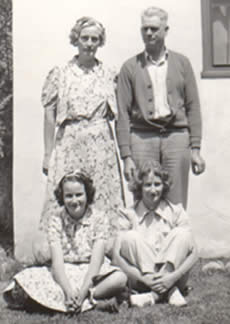
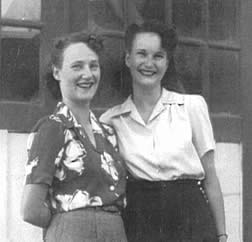
Hazel and Helen
Read more about Hazel in the Summer 2004 issue of The Corralitos Report
